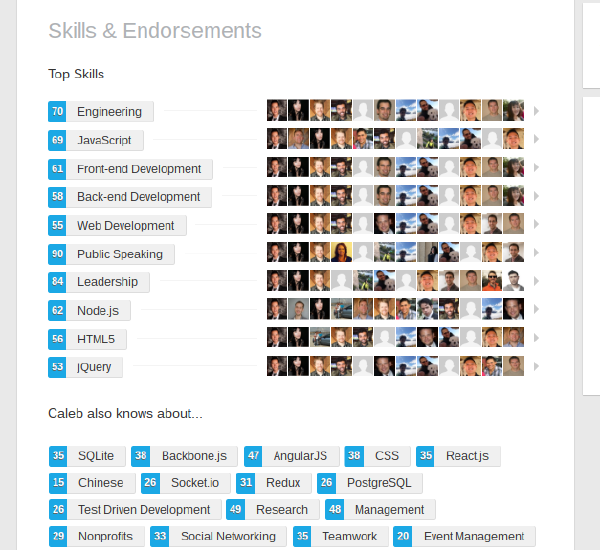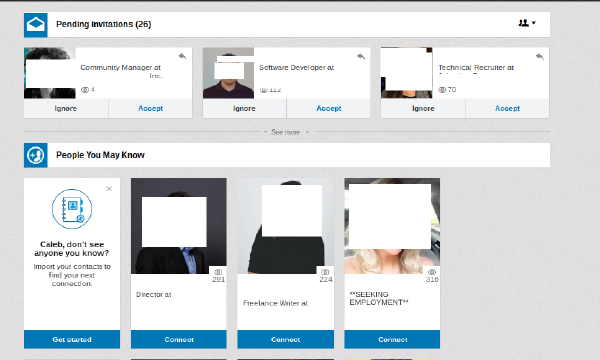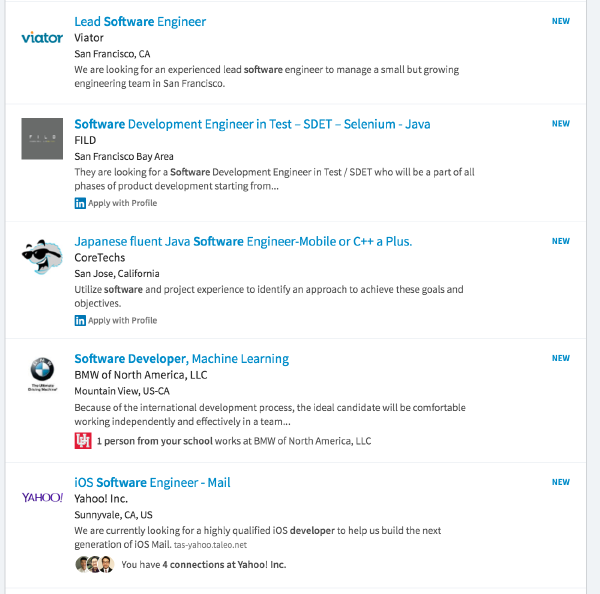LinkedIn is the ubiquitous job-search tool recommended by everyone, ever, for a reason - it’s useful. I’ll tell you how I used it, and I got a job out of Hack Reactor pretty quick, so trust me on this stuff. Out of everything that goes into a job search as a coding bootcamp grad, using LinkedIn is what I’m most confident in.
Imagine an A-10 Warthog:
https://www.youtube.com/embed/lCCty8DpUwk
It’s a gun that the U.S. military built a plane around. The gun is the GAU-8 Avenger. It’s an autocannon with 7 barrels and fires three-thousand-nine-hundred 30mm rounds per minute.

Three thousand of these per minute.
When the A-10 shows up, everything it points at disintegrates into fine powder in seconds. To maximize LinkedIn’s potential during your job hunt, that’s what you need to become.

The first, possibly most important, part is the “summary” here. It’s what people see when they first hit your profile, and the information here is reflected elsewhere in searches. Each of those fields can be edited by just hovering over them and clicking the little pencil or whatever icon LinkedIn chooses on a given week.
Name is obvious - whatever you go by day to day, is on your resume, etc. This isn’t a full legal name field, nobody cares, just put the easiest thing in there. Don’t be annoying and put “looking” or “coding ninja available for work” or something cute like that here. It’s obnoxious. Forget about it.
Headline goes right under your name. If you’re a recent bootcamp graduate, it should say “Software Engineer.” If you’re currently attending a coding bootcamp, it should say “Software Engineer.” This is what appears under your name in searches. No, you are not lying. This is not a legally binding document. This is how you describe yourself to the outside world - you should be describing yourself as a Software Engineer.
Location and Industry should be where you want to work. If you’re a privacy nut, I don’t care, give it up for your job search. You aren’t going to get recruiters turning up to your house because you have your city on here. Computer Software seems to be the best option for industry, let me know if something better has been added to the dropdown.
Current, previous, education are pulled from your profile, which you should have filled out with relevant job experience. If you went to college, that should be the only “education” experience that has dates attached, which will ensure it appears under “education.” Otherwise your bootcamp will end up there, and instead of people seeing Caleb Rogers - Software Engineer, B.A. University of Houston Creative Writing they’ll see Software Engineer, no degree at Makersquare or something equally horrifying. Put your bootcamp under education so you can easily find alumni (expanded on below), but don’t put dates. If you had a reasonably professional job previously, set it as your “current.” Just set it as your “present” job instead of putting an end date. Don’t get into a huff about this, the Employment Police are not going to hunt you down over this. If someone asks you can just say “oh, I finished with them a few months back, I just haven’t updated my LinkedIn yet, whoopsie!” If it gets you a call from a recruiter, who cares if it’s not technically true?
LinkedIn URL can be decided by you, make it something sane so it looks good on your resume, website, email signature, and other places you link it. First Middle Last, Last First, whatever, something professional, like your email address (hopefully).
Contact Info Click “contact info” and it’ll drop down this box full of stuff. Fill out all the fields you can. You want it to be as easy as possible for a recruiter to get a hold of you. Yes, that means your information is right out there and available for anybody. You’ll probably get a lot of calls from recruiters, some of whom have jobs that are way outside your experience. At least you’re getting calls! After you get a job you can wipe this out, but for now, get your phone number up there, get your email, your blog, whatever, be as visible and easy to contact as possible. The more recruiters that reach out to you, the sooner you get a job, the sooner you can stop exposing yourself to the raw unbridled force of the internet.

Previous Jobs should have nice big fat paragraphs describing how you were super awesome at that job. Bonus if you can sneak in anything software-engineering related that you did. Attach pictures, it makes your LinkedIn stand out. If you’re strapped for time, just paste in the description whatever you’ve got on your resume.
Volunteer should be filled out with any random thing you can think of that you’ve done. It makes you look wholesome. If you have nothing, go issue some PRs on an open source repo. Find spelling errors on a non-profit’s website. Whatever. Mention the time your boyscout troop cleaned a beach in 1998. Something.
Skills and Endorsements is important. If you’ve got Microsoft office on there, get rid of it. If you’ve got “being sarcastic,” get that shit out of here. This is your chance to get hit on searches for technologies. Paste your whole “skills” section of your resume in here. Coordinate with your cohort to upvote eachother in ALL of your skills. Whenever you get a new contact, click the little + next to every one of their skills and they may do the same for you.

Do all the above before you touch anything else on LinkedIn. If you start sending out connect requests and get rejected because your LinkedIn profile makes you look like a bot because of how empty it is, you’ll close yourself out of a lot of potential opportunities.
LinkedIn is a way for you to contact people in the industry. Those people might be recruiters, engineering managers, decision makers, alumni, whatever. Every opportunity to contact these people is a potential opportunity to get interviewed. You want as many interviews as possible, so it follows that you want to contact as many people as possible. Without appearing like a spambot, of course.

Top right of the page on LinkedIn has a little picture of a person with a + next to it. Click it. You’ll be brought to a screen that looks like:

You’ll have pending invitations (maybe) and “people you may know.” Pretend you are an A-10 Warthog, spin up your giant friggin cannon, and click “accept” and “connect” on every person on this page. Then refresh and do it again. Then refresh and do it again. Do this every day, multiple times per day. Now go to the search bar, type in “software engineer,” do a “people” search (as opposed to job or company), filter by wherever you are. Connect with everyone on the first page that doesn’t require LinkedIn Premium to connect with. If you get brought to a screen that says “enter their email,” press back and keep connecting with other people until you get that screen every time. Then wait a day and do it again, but this time for “front end developer,” or “back end developer,” or “developer,” or “software developer.” Flak cannon.
When people see me rapidly clicking through my connections and invitations, they are always surprised. “But, you don’t know those people! You’re connecting with them?” Yes, I am, what of it? What does a connection get you? If you haven’t done a people search yet, do one now. Notice how some people have “send inmail” next to their name instead of “connect?” That’s because they’re a 3rd degree person instead of 2nd degree. Basically, you aren’t connected with anybody that they’re connected to. You can’t connect with them and thus you’ll never be able to message them unless you pay LinkedIn to let you. If you want to be able to message a metric shitton of people, you’ll need to get as many 1st degree connections as possible. With 1st degree connections comes exponentially more 2nd degree people, who are only a click away from becoming 1st degree. Look, just do it, this isn’t Facebook, the only thing LinkedIn is good for is getting you a job.
 A 2nd degree connection can be added to become a 1st degree connection, who you can then message.
A 2nd degree connection can be added to become a 1st degree connection, who you can then message.
Now you’ll have a nice set of hundreds of jobs ripe for the picking:

Each result has some basic information - the company name, job title, short job description. That’s all helpful, but the best bits are what come after. In the above image, under the BMW job, note that it says “1 person from your school works at BMW.” This is why you filled out your education section earlier. Now I can click that little link, see which of my alumni work there, and connect with or message them. If I see a lot of bootcamp grads there (instead of my university), I know that that company is probably friendly to the concept of bootcamps and should take priority for my applications.
Now check out the Yahoo job. I have 4 connections there. That’s 4 people I can message right now to get more information about the company, maybe grab coffee with, and potentially approach about putting in a referral for me. That’s why you blast out connection requests.
The CoreTechs and FILD jobs are good little nuggets as well, because they use LinkedIn’s one-click resume send feature. Once or twice a week I like to blast through a good number of those because they take seconds of time and could turn into a phone call. If it’s a job you’re extremely interested in, probably better to pursue other routes, but the one-clicks are good to get a fat chunk of resume sends out on a slow day.